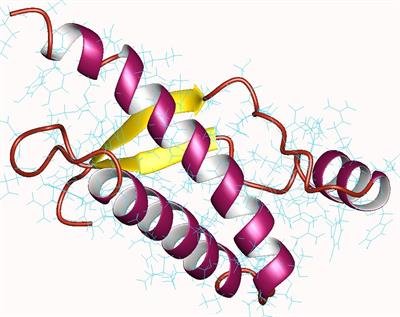
PUMPA - SMART LEARNING
எங்கள் ஆசிரியர்களுடன் 1-ஆன்-1 ஆலோசனை நேரத்தைப் பெறுங்கள். டாப்பர் ஆவதற்கு நாங்கள் பயிற்சி அளிப்போம்
Book Free DemoIn \(1982\), American neurologist Stanley B. Prusiner discovered a class of infectious self-reproducing pathogens called prions. He also coins the term as prion. These are different from viruses and even smaller than a virus.
The word 'prion' means proteinaceous infectious particle, i.e., pathogenic viral particles containing only proteins. But they do not contain nucleic acid. They are the rod-shaped cell surface glycoprotein found in neurons.
Prions induce normal proteins present in the brain to fold abnormally. The misfolding of proteins are called as prion proteins (\(PrP\)). Misfolded proteins start to accumulate and create clumps or plaques are known as amyloids. Abnormal folding resulted in the degeneration of nervous tissue.

Model of a prion protein
Prions are responsible for several neurodegenerative diseases in humans and many other animals.
Example:
Bovine spongiform encephalopathy (\(BSE\)):
It is commonly called "mad cow disease," this type of prion disease affects cows mainly. Humans who consume cows meat with \(BSE\) are at risk of vCJD (Variant Creutzfeldt-Jakob disease).
Creutzfeldt-Jakob disease:
Creutzfeldt-Jakob disease (\(CJD\)) is a rapidly progressive, fatal neurodegenerative disease caused by an abnormal isoform of a cellular glycoprotein called the prion protein. As a result of this disease, the cerebral cortex is affected and is characterised by progressive dementia, memory loss, behavioural changes, poor coordination and visual disturbances.
The abnormal folding and aggregation of prions in the brain cause damage in the brain, which leads to
- Memory impairment
- Changes in the personality
- Difficulties in moving
- Dementia
- Muscle stiffness
- Difficult to speak
- Insomnia (trouble in sleeping)
Reference:
https://commons.wikimedia.org/wiki/File:1e1w.jpg